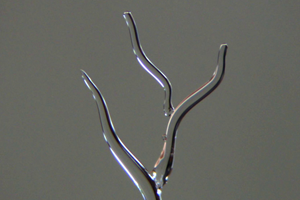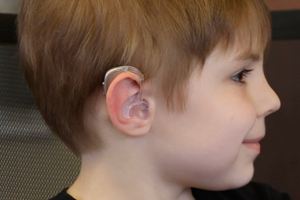Stratasys Partners With Ricoh for Print-On-Demand Medical Models
This offering gives clinicians and patients increased access to patient-specific, 3D printed models for preoperative surgical planning, diagnostic use and surgical education to improve clinical outcomes and drive significant savings through improved productivity.
Share
Anatomic 3D printed models enable medical staff to practice and plan for surgeries. Photo Credit: Stratasys
Stratasys has signed an agreement with Ricoh USA to provide on-demand 3D-printed anatomic models for clinical settings. Stratasys’ patient-specific 3D solutions combines 3D printing technology from Stratasys, the cloud-based Segmentation-as-a-Service solution from Axial3D and precision additive manufacturing (AM) services from Ricoh into one convenient solution.
The new service builds on an existing relationship between Ricoh 3D for Healthcare and Stratasys to expand access to 3D-printed medical models. The partners say offering this solution means democratized, wider access to patient-specific 3D-printed models that can improve outcomes and the patient experience, while also enhancing physician education and training.
Anatomic 3D-printed models are realistic, specific visualizations of a patient’s anatomy, enabling practitioners to plan and practice complex surgeries and improve communication between medical staff, the patient and their families. Digital Anatomy technology from Stratasys even enables these models to be biomechanically realistic, with the feel and responsiveness of real bone and tissue.
While this method of surgical planning offers benefits to patients and care teams, the need for up-front capital investments and on-site 3D printing technical expertise are significant barriers to its adoption. It is said this new service removes those barriers to expand access to more hospitals and clinics, and ultimately contributes to better outcomes.
This offering gives clinicians and patients increased access to patient-specific 3D-printed models for preoperative surgical planning, diagnostic use and surgical education. Using these models, clinicians can demonstrate treatment decisions to patients and surgical staff. Surgical planning with patient-specific 3D models can improve clinical outcomes and drive significant savings through improved productivity.
With this collaboration, customers can upload medical files to a secure, cloud-based service where Axial3D’s artificial intelligence-powered software automatically converts medical scans into 3D-printable files. The files are then printed on Stratasys 3D printers at Ricoh’s ISO 13485-certified facility, with the models shipped directly to the care facility. These changes enables a process that normally takes weeks to instead be completed in days, without the need for on-site 3D printing equipment or AM technical expertise.
“With the advancement in imaging techniques and 3D printing technology, we are seeing an increased demand for personalized solutions,” says Ben Klein, general manager, Stratasys patient-specific solutions. “We offer a simplified and scalable, comprehensive solution that increases access to patient-specific, 3D printed models in a fraction of time to help deliver highly personalized treatment and care.”
The partnership builds on the companies’ history of collaboration. Ricoh’s quality control processes, manufacturing expertise and health care experience provide the specialized production capacity necessary to scale access to models produced using Stratasys technology.
“We are providing an opportunity for health care providers to access state-of-the-art, precision additive manufacturing without absorbing the overhead costs,” says Gary Turner, managing director of AM, Ricoh USA. “Offering this solution means democratized, wider access to patient-specific, 3D printed models that can improve outcomes and the patient experience, while also enhancing physician education and training.”
- Learn about other Stratasys collaborations with health care and medical device companies to deliver visual and functional anatomical models to improve patient care and outcomes.
- Read how Hexagon and Stratasys are unlocking 3D Printed PEKK’s lightweighting for aerospace as rigorously validated multiscale models of these high-performance, aerospace-approved materials have been added to Hexagon’s Digimat materials exchange ecosystem with associated print process parameters from Stratasys’ aerospace-ready 3D printers.
- Check out this article on NASA’s Orion spacecraft which includes parts 3D printed from electrostatic dissipative Antero 800NA from Stratasys.
Related Content
Formlabs Part Removal Mechanism Enables Lights-Out Production
A build platform overcoming the need for manual part removal enables automated part handling, and therefore continuous production from one build cycle to the next.
Read MoreIce 3D Printing of Sacrificial Structures as Small as Blood Vessels
Using water for sacrificial tooling, Carnegie Mellon researchers have created a microscale method for 3D printing intricate structures small enough to create vasculature in artificial tissue. The biomedical research potentially has implications for other microscale and microfluidics applications.
Read More3D Printing Startup to Deliver Thousands of Custom Hearing Aids Over Next Five Years
Starting with a pilot program in Jordan, nonprofit 3DP4ME is developing workflows to 3D print hearing aid earmolds and prosthetics near the people who need them.
Read MoreUnderstanding PEKK and PEEK for 3D Printing: The Cool Parts Show Bonus
Both materials offer properties desirable for medical implants, among other applications. In this bonus episode, hear more from Oxford Performance Materials and Curiteva about how these companies are applying PEKK and PEEK, respectively.
Read MoreRead Next
3D Printing Brings Sustainability, Accessibility to Glass Manufacturing
Australian startup Maple Glass Printing has developed a process for extruding glass into artwork, lab implements and architectural elements. Along the way, the company has also found more efficient ways of recycling this material.
Read MoreHybrid Additive Manufacturing Machine Tools Continue to Make Gains (Includes Video)
The hybrid machine tool is an idea that continues to advance. Two important developments of recent years expand the possibilities for this platform.
Read MoreAt General Atomics, Do Unmanned Aerial Systems Reveal the Future of Aircraft Manufacturing?
The maker of the Predator and SkyGuardian remote aircraft can implement additive manufacturing more rapidly and widely than the makers of other types of planes. The role of 3D printing in current and future UAS components hints at how far AM can go to save cost and time in aircraft production and design.
Read More






















